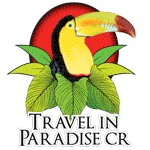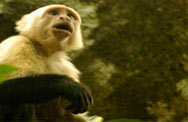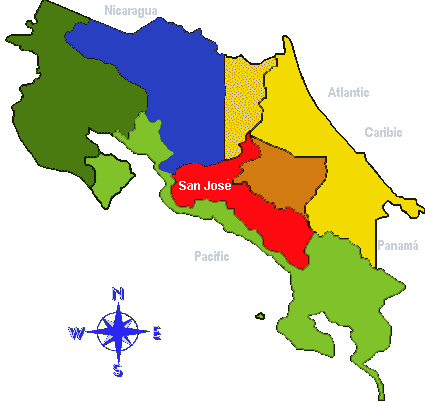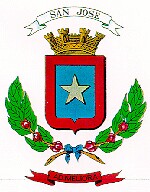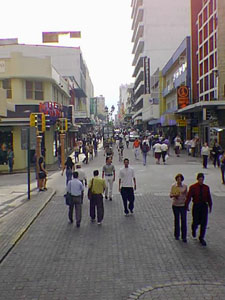#1 Costa Rica Travel in Paradise, Costa Rica Vacations |
|
|
||||||||||||||||
|
Home| Escorted Trip | Family Trip | Honeymoon |Tailor MadeTours | Rent a Car | Hotel | One Day Tours| About C R| Testimonial | FAQ | Contact Us | About Us | Terms| How to Book
|
||||||||||||||||
Climate: The province of San Jose includes areas representative of practically every climatic regime possible in Costa Rica since its territory extends from almost sea level at several points near the central Pacific coast up to the country's highest peak, Mt. Chirripó, at an elevation of 3,820 m. Additionally, a small portion of the province protrudes down the very wet eastern slopes of the Central Volcanic Cordillera in a section of Braulio Carrillo National Park. Thus, the entire range of temperatures and rainfall patterns that affect Costa Rica can be experienced somewhere in the province. Nonetheless, the majority of the province of San Jose is blessed by a moderate climate where nothing more than a sweater or lightweight jacket and an umbrella are all the protection from the elements you'll ever need. This mild climatic region lies in an altitudinal band between 700 and 1300 meters above sea level and is under the influence of a distinct dry season from mid-November through mid-May and a corresponding wet season during the remaining half of the year -- the characteristic weather pattern for essentially all of the nation's territory on the western side of the continental divide.History: The province of San José is the most populated of Costa Rica's seven provinces and is the seat of the nation's capital, the city of San José. In the early years of the Central Valley's colonization (1560's), families began spreading west from the village of Cartago, and one of the first places settled was the valley of Aserrí (to the south of what is now the city of San José). Some 170 years later, in 1736, the authorities ordered the inhabitants of the valley of Aserrí to move to a site known as "Boca del Monte" and to this end erected a church dedicated to Saint Joseph, which was finished in 1738 -- on a site which is across the street from the east side of what is now the Central Bank. The parish became known as "San José de la Boca del Monte en el Valle de Aserrí". Due to problems with lack of water in the immediate area around the church, however, the inhabitants of Aserrí refused to move to the new site. In 1751, water was finally piped to the area, also known as Villa Nueva, but the residents of Aserrí still had to be almost forced to at last move to the new town. By 1824, the population of San José had grown to more than 15,000 and a year earlier the city had become the capital of the newly independent country -- this came after a brief civil war over whether to remain independent (a view backed by residents of San José and Alajuela) or become a part of the Mexican empire (supported by the citizens of Cartago and Heredia). Following the victory of those favoring independence, the capital was moved from Cartago to San José. National Parks: 1) Braulio Carrillo National Park 2) Chirripó National Park 3) Carara Biological Reserve
Other Points of Interest: 1) Los Cusingos Neotropical Bird Sanctuary (Dr. Skutch's farm): This small forest reserve has been the private home of Dr. Alexander F. Skutch since 1941. When Dr. Skutch first purchased the land, the cleared area around the house was one of the few clearings in the entire valley of San Isidro del General. By the close of the 20th century, his property has become one of the last remaining forested patches in this now agricultural landscape, where he and his wife live much as they did when they first settled the land -- without motor vehicles, electricity, or telephones.Visitors to the farm may walk the trail into the forest or along the Peñas Blancas River to personally view some of the many plants and animals, especially birds, that Dr. Skutch has written about over the years. The author of more than twenty books and contributor of countless articles published in the scientific literature, Dr. Skutch is undeniably the foremost naturalist living in Costa Rica. A highlight of any visit to Los Cusingos is sitting on the porch and watching the birds that come to the feeding tray across the yard. Among the most frequent species at the feeder are Scarlet-rumped Tanager, Green Honeycreeper, Buff-throated Saltator, Bananaquit, and Speckled Tanager. Most every afternoon (and sometimes in the morning) a male Turquoise Cotinga -- a stunningly plumaged bird -- can be found sitting in the big mayo tree visible from the porch. Admission policy: In 1993, the Tropical Science Center (the same private organization that owns and operates the Monteverde Cloud Forest Reserve) entered into an agreement with Dr. Skutch to take over the management of Los Cusingos. They now handle reservations for interested visitors through their San José office (tel: 253-3267 / fax: 253-4963). An entrance fee of $8 per person is charged (as of March 1995), and visitation is limited to 15 persons per day. Getting there: Solicit directions from the Tropical Science Center when making your reservations.Climate: Expect mornings to be hot all year long. Thundershowers are a possibility in the afternoon, even during the dry season (December - April). Insect repellent is recommended since there are frequently small black flies that can be bothersome. History: Dr. Skutch bought this piece of land in 1941 for the purpose of being able to study the life histories of the many neotropical bird species that inhabited it. The name Los Cusingos comes from the local common name for the Fiery-billed Araçari, a slender member of the toucan family. Dr. Skutch chose this name because of all the numerous native bird species on the farm this was one that was well known to neighboring residents and also is a species unique to the southern Pacific portion of Costa Rica and western Panama. It has also persisted over the years while other large species have disappeared due to the amount of deforestation in the region.
2) El Rodeo Forest Reserve: Almost 400 hectares of forest still remain on this large cattle ranch in the southwestern corner of the Central Valley. The forest is not all in one block, however, but scattered about the property in patches of varied sizes. Some of the larger sections are across from the old hacienda building and beyond the United Nations University for Peace (the Costa Rican campus of this prestigious institution is also located within El Rodeo land). You have to cross some pasture to get to these forests. Another alternative is taking the gravel road to the right just before reaching the University for Peace and following it down towards the community of Piedras Negras, stopping whenever you come to some forested portions.This area is known by butterfly enthusiasts for having a number of rather handsome species that are not easily found elsewhere in the country. Birdwatchers will find a mixture of middle-elevation and dry forest species inhabiting the different ecosystems in this premontane moist forest, some examples are: Blue-crowned Motmot, Rufous-and-white Wren, Lesser Ground-Cuckoo, Fiery-billed Araçari, and Red-crowned Ant-Tanager.Getting there: From San José, take the Santa Ana highway west (picked up on the south side of the Sabana Metropolitan Park) to the town of Ciudad Colón, about 17 km. Follow one-way traffic uphill through the town and turn off to the right just before the road resumes two-way traffic. It's about another 6 km. to El Rodeo. Climate: At an elevation of approximately 600 meters, this area stays warm throughout the year. The dry season has a pronounced effect from December through April.
3) Simón Bolivar National Zoological Park: This small zoo is operated by the National Park Service, and although it is not on a par with modern zoos in more developed countries, it does provide an opportunity to view numerous species of native wildlife that are not all that easily seen in the wild, even after a week or two of walking trails through different national parks.Admission Policy: The zoo is open Monday through Friday from 8:00 a.m. - 3:30 p.m., and on weekends and holidays from 9:00 a.m. - 4:30 p.m.Getting there: From the Morazán Park, take calle 7 north for three blocks and turn right on avenida 11. Bear right at the T-intersection and you'll come to the entrance gate.5) The National Theater: San José's foremost architectural showpiece, the National Theater is a source of pride to Costa Ricans everywhere. Inaugurated on October 19, 1897 with a performance of "Faust" by the Paris Opera Company, the building's origins date to 1890 when the Italian opera singer, Angela Pelati, gave a number of performances in Guatemala but refused to come to Costa Rica due to the lack of a proper theater. The members of the country's coffee elite proposed that a theater be built in San José to correct this situation and agreed to contribute five centavos per exported sack of coffee to finance the construction.Some parts of the theater were crafted in Europe and shipped to Costa Rica for assembly, such as the metal framework which was cast in Belgium and many of the statues, murals, and ceiling frescos which are the work of Italian artists that never saw Costa Rica. The stunning baroque design features ample use of 221/2 karat gold overlay and Carrara marble. The National Symphonic Orchestra season runs from March to November with performances on Thursday and Friday evenings and again on Sunday mornings. Periodically, other activities ranging from the Moscow ballet and Chinese acrobats to state dinners and Costa Rican theatrical presentations are also scheduled. The coffee shop adjoining the main lobby is a wonderful place to sit and watch the world go by. During the day the building is open to the public for viewing from 9:00 a.m. to 5:00 p.m., Monday through Saturday. Phone: 221-1329. 4) Various museums in San José: National Museum: Best known for the variety of pre-Columbian artifacts on permanent display, the National Museum also has exhibits dedicated to Costa Rican religious art and the history of the country since the Spanish conquest. The building itself has historic significance since it was once a military fortress and after the abolishment of the army, following the Revolution of 1948, was converted into the museum. The museum is located on calle 17, between avenidas central and 2, hours are from 8:30 a.m. to 5:00 p.m., Tuesday through Sunday. Phone: 257-1433.Gold Museum: Operated by the Central Bank of Costa Rica, this museum houses an extensive collection of pre-Columbian gold in which the level of artistry achieved by native craftsman working with this precious metal is easily appreciated.The entrance to the museum is on calle 5, beneath the Plaza de la Cultura, hours are from 10:00 a.m. to 4:30 p.m., Tuesday through Sunday. Phone: 233-4233.Jade Museum: Although the numerous pre-Columbian jade pieces on display are among the most impressive anywhere, the museum also features excellent examples of indigenous craftsmanship in stone, ceramics, and gold. Housed on the 11th floor of the National Insurance Company (INS) building, the view of the city and surrounding mountains is an added attraction to a visit to this museum.[PLEASE NOTE THAT THE JADE MUSEUM WILL BE CLOSED FOR THE REST OF THE YEAR 2000 -- they claim it's due to repair work on the elevators.]Located on avenida 7, between calles 9 and 11, hours are from 8:00 a.m. to 4:30 p.m., Monday through Friday. Phone: 223-5800, ext. 2581.Costa Rican Art Museum: Rotating selections from the permanent collection together with temporary exhibitions showcase the artwork of Costa Rican painters and sculptors in a building that was once an airport terminal. The Sabana Metropolitan Park which stretches west behind the museum was formerly the international airport landing strip in the days prior to jet planes.Located at the western end of Paseo Colón (avenida central), hours are from 10:00 a.m. to 4:00 p.m., Tuesday through Sunday. Phone: 222-7155.Children's Museum: Many hands-on exhibits designed to make learning fun are a highlight of this museum which brings science, culture and history to life (or at least nearly so through the use of robotized Costa Rican personalities). One of the country's newest museums (inaugurated in 1994), it occupies what was once a prison.Located at the northern end of calle 4, hours are from 9:00 a.m. to noon and from 2:00 p.m. to 5:00 p.m., Tuesday through Friday, and from 10:00 a.m. to 5:00 p.m. on Saturday and Sunday. Phone: 223-7003.Museum of Entomology: If bugs are your thing, or you're just looking for a different way to spend a rainy afternoon in the city, then you'll enjoy trying to find this museum. Located on the University of Costa Rica campus in San Pedro, this vast collection of insects is on display in the basement of the Musical Arts Department (Escuela de Música) -- of all places! Hours are from 1:00 p.m. to 4:30 p.m., Monday through Friday. Phone: 207-5647.
Travel Tips:
|
FAQs: You might be wondering too. What to pack: click here to get ideas on what you really need to bring along. What to wear: click here to get ideas on what to wear. Avoid mistaken clothes. Our Specialty Your Best Travel, vacations Family Trips, Honeymoons, Educational Trip, Escorted Trip. Honeymoon Beyond a romantic setting, a honeymoon in Paradise is a magical experience. Family oriented Trip : Is about experiencing fascinating cultures, family adventures, family tours, quality time together. Incentives travels: Creative ideas, consulting services for a theme party or special event.
|
All rights reserved.
All contents Copyright © 2004 -2015 Costa Rica Travel In Paradise Group Tours
|
